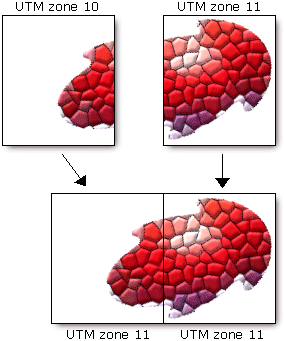Coordinate systems, such as State Plane and UTM, use zones to minimize distortion. Often, a study area crosses two zones, and features at the edges of these zones do not match. There are two ways to perform analysis on an area falling in two zones. The first and easier way is to project one of the coverages into the zone of the adjoining coverage. In the example below, zone 10 was projected to zone 11 because the majority of the study area falls in zone 11.

The other method for joining zones is to project both coverages into a different projection that has no zones. This method is shown in the example below. The different projection is usually the base projection of the original zone, such as Lambert conic conformal or transverse Mercator. To learn more about selecting a projection, see Choosing a map projection.

Be aware that both methods increase the amount of error caused by projection distortion. Error will increase with distance from the standard lines of the projection. To determine the severity of this error, plot the original zone and the extended zone together and note their differences.
Feedback on this topic?